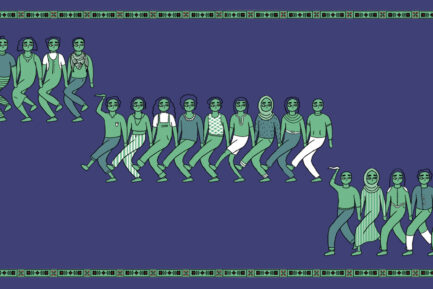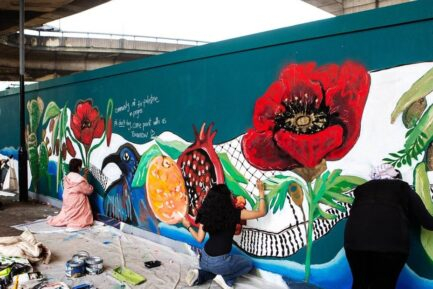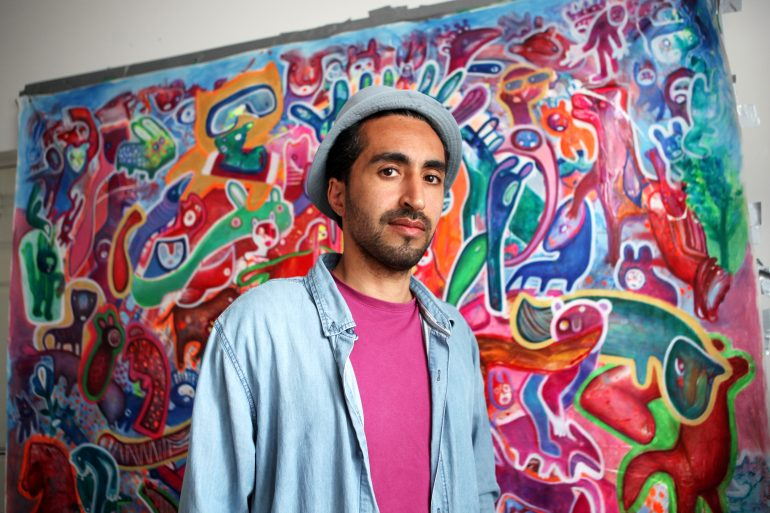From 22-24th May, members of the Palestinian Youth Movement (PYM) alongside the Fearless Collective invited the local community to join us on Latimer Road in West London to paint a mural under the Westway dual carriageway.
The PYM is the largest grassroots organisation of Palestinian and Arab youth worldwide; and Fearless is a South Asian collective of artists that create public art interventions in collaboration with invisibilised and marginalised communities.
While painting only officially began on 22nd May, the work of the mural began well before. After securing a wall for the project, we delivered a workshop with young people in the local community in order to co-develop the mural design on the theme ‘Resistance Until Return’ and how we could collectively enact our theory into practice.
The mural design included paintings of the cactus, the key and the keffiyeh – three important symbols of Palestinian resistance. The mural also included archival imagery from pre-Nakba Palestine, as well as portraits honouring Palestinian martyr-prisoner Walid Daqqa who died of medical negligence within Israeli prison walls earlier this year, and Notting Hill martyr Kelso Cochrane who was murdered on the streets of West London in 1959.
After the mural was complete, a closing ceremony was held at the mural site that brought together local artists, musicians, and community members. So, why did we decide to take up the project of a mural, and why now?
Art in service of liberation
In the PYM, we understand artistic and cultural production to be a tool of resistance: a battlefront in the struggle and a primary site of political engagement. Historically, arts and culture have served as forms of sustenance and unity, creating shared identity and collective consciousness as a rejection of attempts to fragment the Palestinian people.
In the diaspora, we sometimes see Palestinian art and culture being used to depoliticise our cause: popularised through phone covers, key chains, stickers, and posters usually without deep, meaningful or critical engagement on the role of art in our liberation struggle.
We believe that we therefore have a critical role to play from within the diaspora to emphasise the role of art and culture, historically and today, as a politicising tool to drive our struggle forward. This is why the PYM has taken on a number of resistance arts projects, from the Ghassan Kanafani Resistance Arts Prize to the Nakba 75 Poster project.
Ghassan Kanafani often spoke about the politicising nature of creative production. The late revolutionary and writer said: “my political position springs from me being a novelist, not the other way around.”
To us, this perfectly illustrates the power of artistic production: that it is through the creative production process itself that individuals can reach a heightened level of political consciousness.

Artwashing
As well as understanding artistic and cultural production as a tool for raising popular consciousness, the PYM also understands producing popular art as a form of resistance against the complicity of the arts industry.
In Britain, since the beginning of the current and ongoing genocide in Gaza, we have seen arts practitioners take action by protesting against Sadler’s Wells Theatre, staging sit-in’s at the Barbican, and taking action outside Pheonix Cinema for their silence and complicity.
Why have people been driven to action?
Sadler’s Wells conducts their finances with Barclays – which is known to have investments in the occupation of Palestine. The Barbican is growing an ugly track record of silencing Palestinian and pro-Palestinian voices and artists, and Pheonix Cinema recently screened an Israeli propaganda film. In spite of artistic interventions, such institutions remain silent on the issue of Palestine.
Meanwhile, in occupied Palestine, the Israeli regime has continued to use culture and the arts to ‘artwash’ its atrocities against the Palestinian people while persecuting and punishing Palestinian poets such as Dareen Tatour and cartoonist Hafez Omar for daring to use their art to speak out.
In a climate where artistic expression is either used to silence Palestinians and invisibilise our 100-year struggle, the mural project became a space for us to reclaim the arts in the service of the popular masses.
Joint struggle
The mural was painted in the week after Nakba Day, when up to a million Palestinians were ethnically cleansed from their homes in 1948, and the weeks before the 7th Anniversary of the Grenfell fire, which saw the Grenfell tower block in North Kensington burn for 60 hours and 72 people killed.
Given the significant loss and dispossession associated with both of these dates, we decided to fill the weeks in between with a project that’s future-focused: a project of material solidarity that highlights the interconnected nature of our struggles and affirms our collective commitment to resistance until justice from Grenfell to Gaza.
This commitment to joint struggle is particularly critical given the British government’s complicity in the displacement, dispossession and murder of both the Grenfell community and of Palestinians.
Subscribe to shado's weekly newsletter
Exclusive event news, job and creative opportunities, first access to tickets and – just in case you missed them – our picks of the week, from inside shado and out.

The 1948 Nakba was made possible by British-facilitated Zionism which saw 500 Palestinian villages destroyed and de-populated and up to 1 million Palestinians forcibly expelled from their homes.
The Nakba is ongoing and we continue to see Palestinians being displaced and ethnically cleansed while the UK Government continues to provide financial and political cover for Israel’s war crimes, whether through the current genocidal annihilation occurring in Gaza or using housing policies and creating military zones to demolish Palestinian homes in Massafer Yatta.
Why West London?
Our choice of mural location was very intentional. In West London, communities near Latimer Road have also faced displacement and dispossession due to the historic and ongoing practices of gentrification and neoliberal urbanism – the very same policies which saw the construction of Westway Bridge which displaced local communities living in the area. Of course, this area was also the site of the tragedy of the Grenfell Tower fire on 14th June 2017, caused by the negligence of the Royal Borough of Kensington and Chelsea and the capitalist interests of corporations like Arconic.
As a result of gentrification and privatisation around the Westway, social marginalisation has increased and class inequality has widened. Unsurprisingly, it is racialised, low-income and working-class communities that have been the most affected by these forms of neoliberal governance policies and continue to be denied access to adequate housing services.
The use of neoliberal policies, underfunding of racialised communities, poor infrastructure and flawed architectural plans have all been used to maintain inequality and forcibly displace and murder residents, illustrating parallels between working class struggles here in Britain with the experiences of Palestinians back home.
Art as reclamation
Art has always been used to reclaim communal spaces that have been robbed from us by capitalist and corporate interests. Following the police murder of George Floyd in 2020, the movement for Black lives’ resistance art has been used to highlight systemic inequality and police brutality. In the immediate aftermath of the Grenfell Fire, local community members took to the Westway to honour the victims lost and demand justice – our mural added to this mosaic of street art that honours the martyrs of Grenfell.
In Palestine, the West Bank apartheid wall has been used as a canvas to visualise the right to return and fight against the erasure of historic Palestine. Public art continues to be used today as a form of resistance against cultural genocide and to globalise the calls for justice and return.
All these examples speak to what Claudia Jones, the mother of Notting Hill Carnival, famously affirmed: that “a people’s art is the genesis of their freedom.”
In the PYM, we understand that one of our critical roles in the diaspora is to forge joint struggle partnerships and solidarity links with those who are fighting against the same systems of exploitation and dispossession. Public art provides a critical opportunity to forge those links, by creating opportunities to heighten political consciousness through artistic and cultural production.
It also serves to resist the de-politicisation and neoliberalisation of artistic and cultural production while simultaneously providing a space to leave a mark of our collective struggle and resistance – this was the motivation behind the mural project.
What can you do?
- You can visit the Mural at 198 Latimer Road
- National Liberation and Culture by Amilcar Cabral
- On Revolutionary Art by Emory Douglas
- Read more shado articles by PYM























